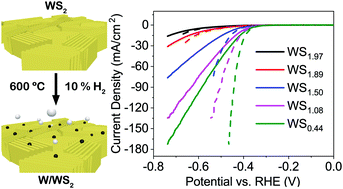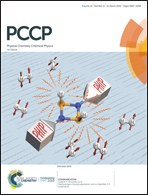Enhancing the electrocatalytic activity of 2H-WS2 for hydrogen evolution via defect engineering†
Abstract
Transition metal dichalcogenides (TMDs), such as MoS2 and WS2, are promising alternative non-noble metal catalysts to drive the electrocatalytic H2 evolution reaction (HER). However, their catalytic performance is inherently limited by the small number of active sites as well as their poor electrical conductivity. Here, we grow vertically aligned 2H-WS2 on different substrates to expose their edge sites for the HER and introduce a scalable approach to tune these active sites via defect engineering. In a thermal hydrogen treatment procedure, sulfur vacancies and metallic tungsten nanoparticles are formed. The extent of desulfurization, and thus the HER activity, can be tuned via controlling the H2 annealing conditions. The obtained W/WS2−x electrocatalysts are evaluated experimentally and theoretically to arrive at a better understanding of how to modify the inherently inert 2H-WS2 for more efficient HER.



 Please wait while we load your content...
Please wait while we load your content...